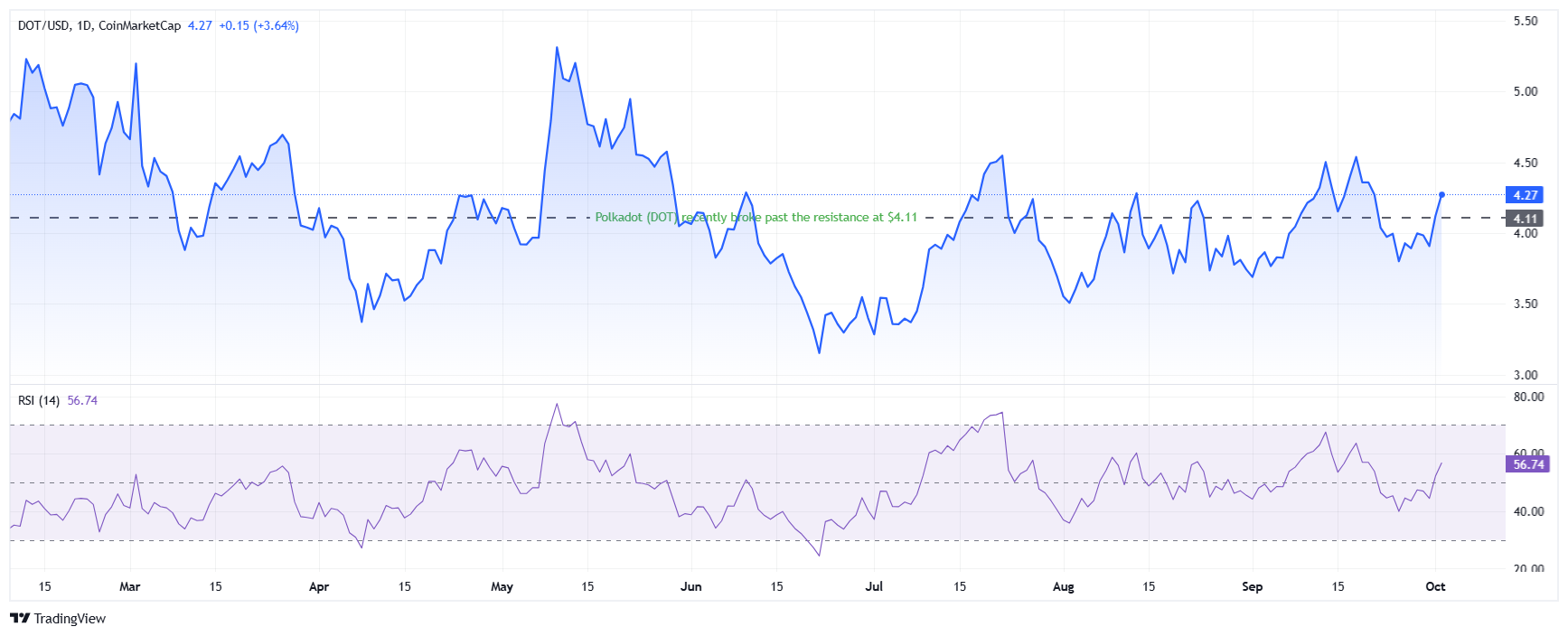TLDR
- Polkadot has surged above key resistance levels, with its price moving towards $4.42.
- The 21Shares Polkadot ETF has been added to the DTCC list, signaling potential approval for institutional investments.
- Analysts estimate a 90% chance of ETF approval by November 2025, which could bring institutional capital to Polkadot.
- Polkadot recently broke a long-term descending trendline, with technical indicators showing room for further upward movement.
- The Web3 Foundation has introduced stricter oversight of its treasury to ensure the more effective use of ecosystem funds.
Polkadot (DOT) has recently gained attention after breaking key resistance levels, fueled by developments on multiple fronts. The cryptocurrency has surged above critical levels, such as $4.28, with its sights set on $4.42. Key factors contributing to this growth include the potential listing of a US-listed Polkadot exchange-traded fund (ETF) and the launch of the pUSD stablecoin proposal. Analysts are now focused on whether DOT can maintain its upward momentum and hold these critical levels.
Analysts Predict 90% Chance for Polkadot ETF Approval
Polkadot’s recent momentum can be attributed to growing expectations surrounding the Polkadot ETF. The 21Shares Polkadot ETF, trading under the ticker TDOT, was recently listed on the Depository Trust & Clearing Corporation (DTCC) National Securities Clearing Corporation list. While this listing does not mean approval for trading, it signifies that preparations for settlement and trading are well underway. The ETF has sparked optimism within the market, especially with analysts estimating a 90% chance of approval by November 2025.
This approval would allow institutional investors to gain exposure to Polkadot through regulated investment vehicles. A successful Polkadot ETF approval would open the floodgates for institutional capital, significantly affecting DOT’s market standing. “Approval of the ETF would be a major milestone for Polkadot,” said an analyst at Bloomberg. The ETF’s potential has also spurred similar initiatives for other cryptocurrencies, such as Solana and Sui, indicating a shift toward more institutional involvement in the space.
21Shares Polkadot ETF (TDOT) and 21Shares Sui ETF (TSUI) have been listed on the DTCC website. This listing is part of the standard preparation process for launching new ETFs and does not indicate that the products have received any regulatory approval or completed other approval…
— Wu Blockchain (@WuBlockchain) September 30, 2025
Despite the ETF’s positive outlook, the broader market is keen on monitoring any regulatory or legal hurdles. If approved, the Polkadot ETF would boost institutional confidence, which would impact both DOT’s price and the ecosystem’s development. The attention from large financial institutions indicates that Polkadot is gaining serious consideration as an investment vehicle in the crypto world.
Polkadot’s Technical Breakout Sparks Bullish Sentiment
On October 1, Polkadot experienced a significant price surge, surpassing its previous resistance level of $4.11. The breakout occurred on high trading volume, five times its average, signaling a substantial technical shift. This move broke a long-standing descending trendline, which had been a barrier for nearly two years. Currently, Polkadot’s technical indicators support the possibility of further upside, with its Relative Strength Index (RSI) at a neutral 52.18, indicating room for continued growth.

Traders are closely watching to see if DOT can hold above $4.28, as this level would signal further bullish momentum. The next key resistance level sits at $4.42, which, if broken, could fuel a continued rally. With growing anticipation surrounding the Polkadot ETF and strong technical indicators, Polkadot’s momentum is capturing the attention of traders and investors alike. The market appears poised for a potential upward shift if Polkadot can sustain this positive momentum.
Market analysts are particularly focused on the potential for DOT to challenge the $4.42 resistance level. Breaking this threshold would open the door to new price levels and spark further institutional interest. As DOT continues to show strength, the cryptocurrency remains a prime candidate for bullish activity in the near term.
DOT Proposes pUSD to Increase DOT Utility
In addition to the ETF developments, Polkadot is undergoing significant governance changes, with the Web3 Foundation introducing tighter oversight of treasury proposals. This initiative aims to reduce the misuse of funds and improve transparency in the ecosystem. Approximately 15% of Polkadot’s inflation is directed toward funding ecosystem projects, and these tighter controls are designed to ensure the funds are allocated efficiently.
The community is also watching the ongoing vote on RFC-155, which proposes the creation of pUSD, a native stablecoin backed by DOT. This stablecoin would be overcollateralized and powered by the Honzon protocol, previously used to manage Acala’s aUSD. Proponents argue that pUSD could provide more utility for DOT, allowing users to borrow against their tokens and use it as a stable currency for treasury operations.
However, the pUSD proposal has sparked debate within the Polkadot community. Some critics view the system-issued stablecoin as a threat to parachain-based projects like Hydration’s Hollar and centralized stablecoins like Tether and Circle. Despite this, supporters believe the pUSD stablecoin could unlock significant new utility and offer an attractive alternative to existing stablecoin solutions.






